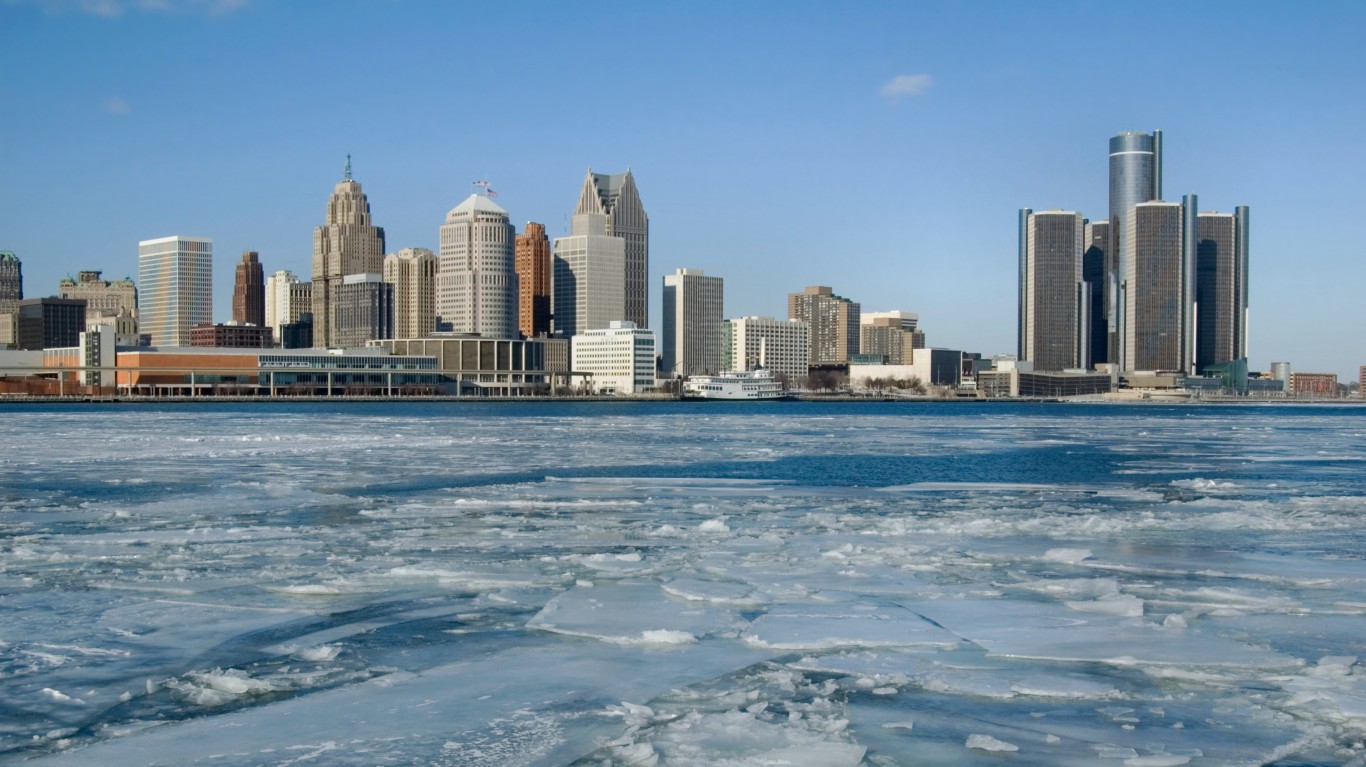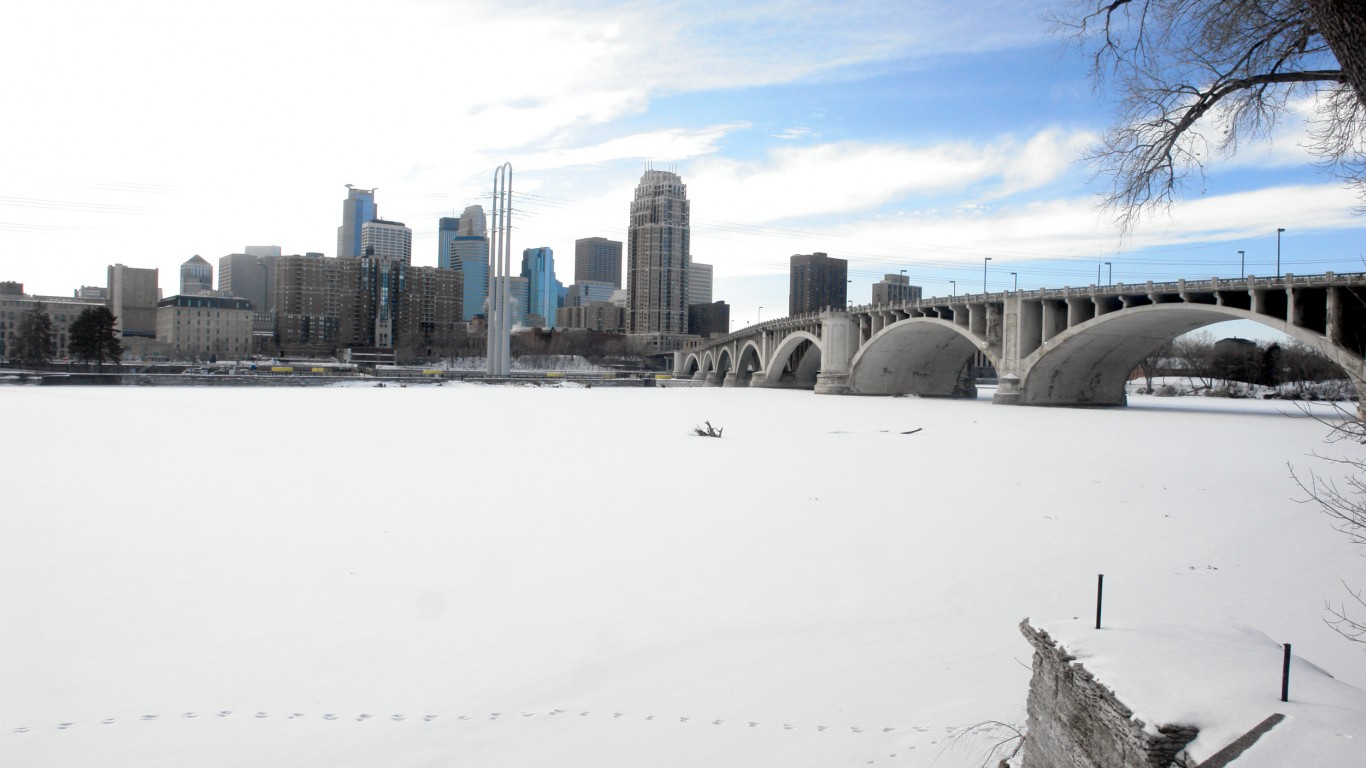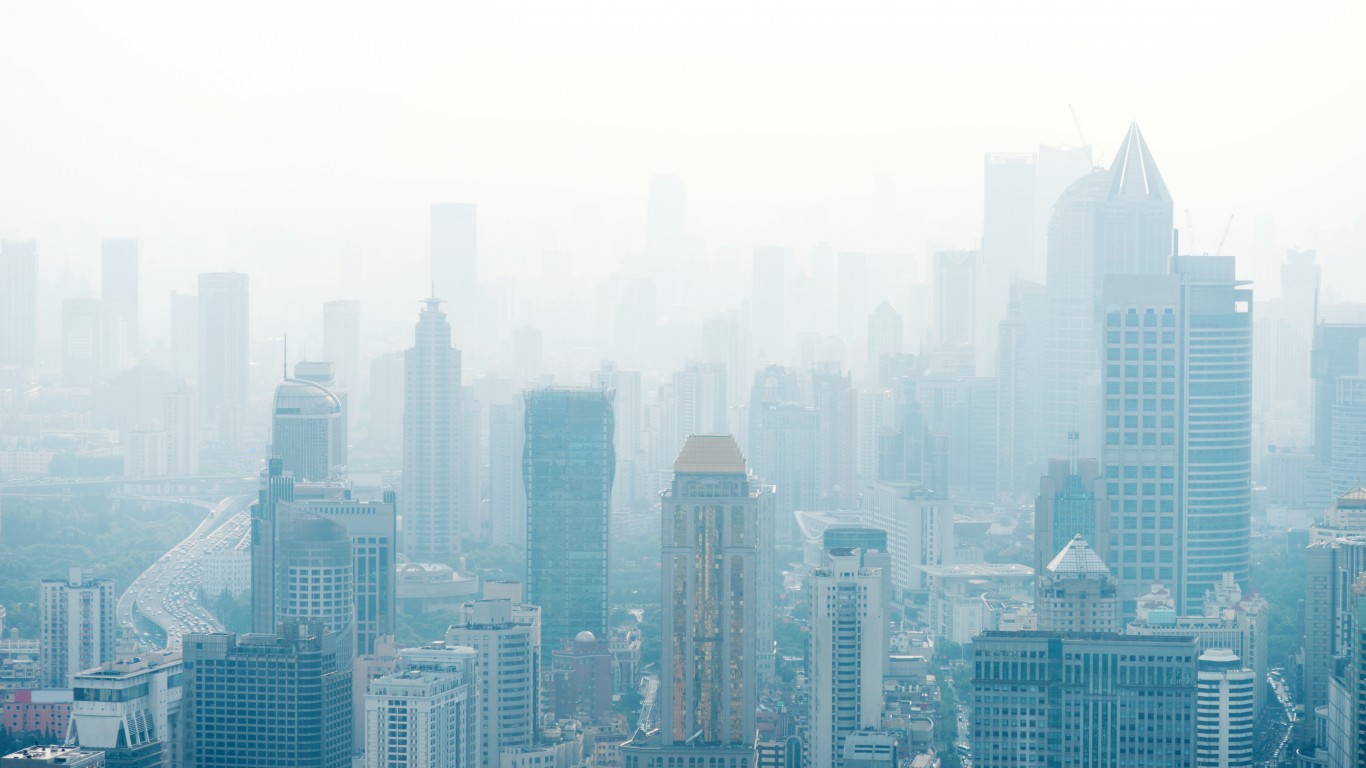
The air we breathe contains all kinds of tiny solid or liquid aerosols that can irritate the respiratory system (think tree pollen, wind-swept dust, and even viruses), but the greatest global airborne health risk is from the smoke plumes emitted by industrial activity, power generation, motorized vehicles, widespread garbage burning, and endemic domestic use of coal or wood to produce heat. (These are the 25 countries increasing emissions the fastest.)
The more harmful particles are the smallest ones, technically known as PM2.5 and defined as particulate matter that is 2.5 microns or smaller in diameter — or about 36 times smaller than a grain of fine beach sand. These microscopic pollutants penetrate into the deepest territories of the body and can be a major contributing factor to such conditions as asthma, stroke, heart and lung diseases, and more. Some evidence suggests it can also hobble brain development in children.
The World Health Organization reduced in September 2021 its air quality guideline for this fine particulate matter to 5 micrograms per cubic meter of air. A recent study of air-pollution monitoring data from 6,475 cities in 118 countries found that 97% of these places do not meet the WHO’s new PM2.5 guideline for healthy air.
To identify the 25 countries with the worst air pollution in the world, 24/7 Wall St. reviewed air quality data from the IQAir 2021 World Air Quality Report. Countries were ranked by PM2.5 annual average concentrations in micrograms per cubic meter (μg/m3). IQAir only used PM2.5 air quality data generated by ground-level monitoring stations. Population figures came from the World Bank and are for 2020. Causes of pollution came from the International Association for Medical Assistance to Travellers.
For the 25 countries with the worst air quality, achieving the WHO’s air pollution guideline is at best a distant goal. In November, India’s sprawling capital of New Delhi experienced a day when the PM2.5 level skyrocketed to an astonishing 706 micrograms per cubic meter of air thanks in part to Diwali holiday revelers ignoring the city’s fireworks ban. India’s annual average concentration PM2.5 level is about 58 micrograms per cubic meter, the world’s fifth highest by country in 2021.
Roughly half the global population live in these 25 countries, where the smoggiest cities tend to house the largest share of the population. The average PM2.5 concentrations in these countries range from nearly 30 micrograms per cubic meter of air in Kuwait to nearly 77 micrograms per cubic meter of air in Bangladesh. (These are 23 places where industrial air pollution is so bad it causes cancer.)
Here are the countries with the worst air pollution
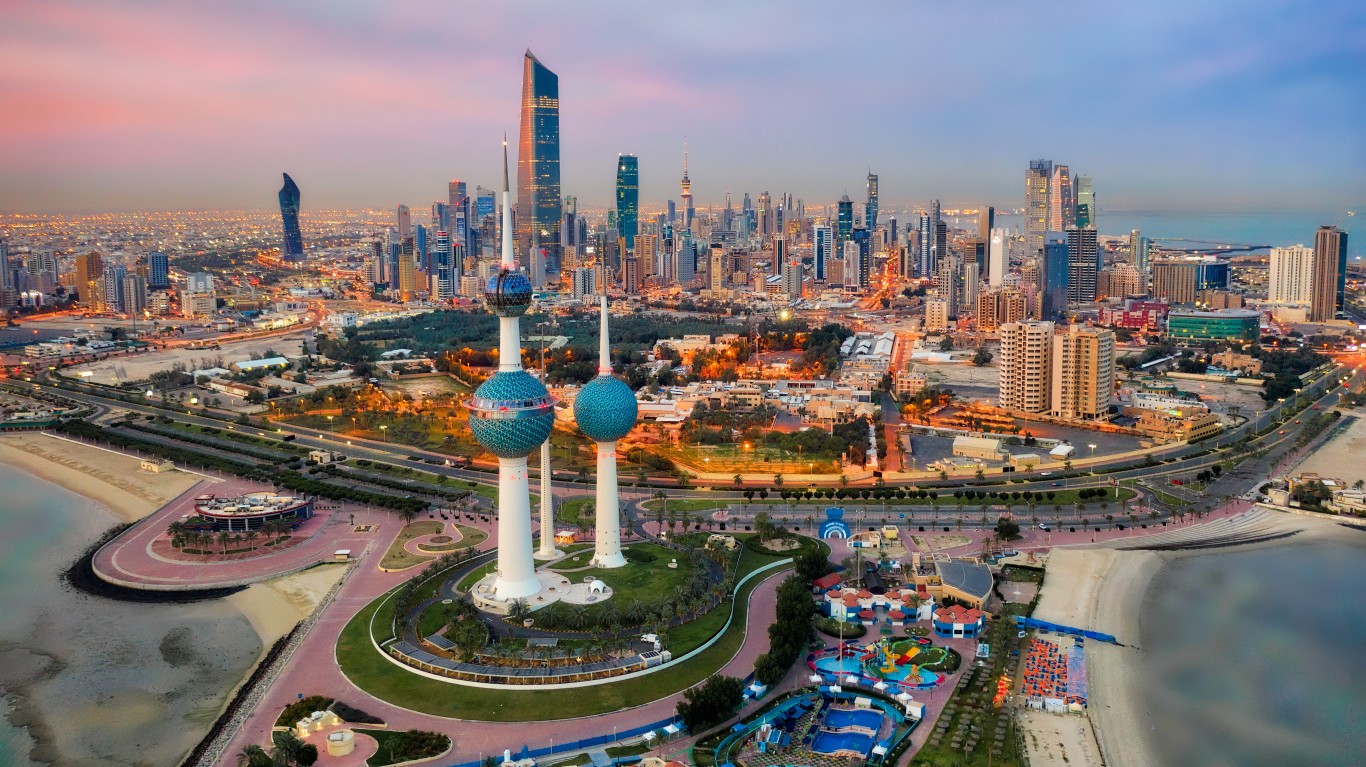
25. Kuwait
> PM2.5 concentration: 29.7 μg/m³
> Total population 2020: 4,270,563
Like its Gulf neighbors, Kuwait’s poor air quality is caused in part by industrial emissions (especially from oil and gas and petrochemical operations) and motor vehicle exhaust. Another source of poor air quality is the seasonal Shamal (“North” in Arabic), a strong northeasterly wind that blows sand and dust for hundreds of miles across Iraq and into the rest of the Arabian Peninsula.
[in-text-ad]

24. Iran
> PM2.5 concentration: 30.3 μg/m³
> Total population 2020: 83,992,953
In addition to cars, the biggest contributors to Iran’s poor air quality are industrial operations tied to oil and gas, petrochemicals, and cement. Over several weeks last year, it was reported that Tehran and other major Iranian cities experienced air quality index readings above 200, defined as “very unhealthy,” meaning older adults, children, and people with heart or lung disease were advised to avoid all outdoor physical activity.
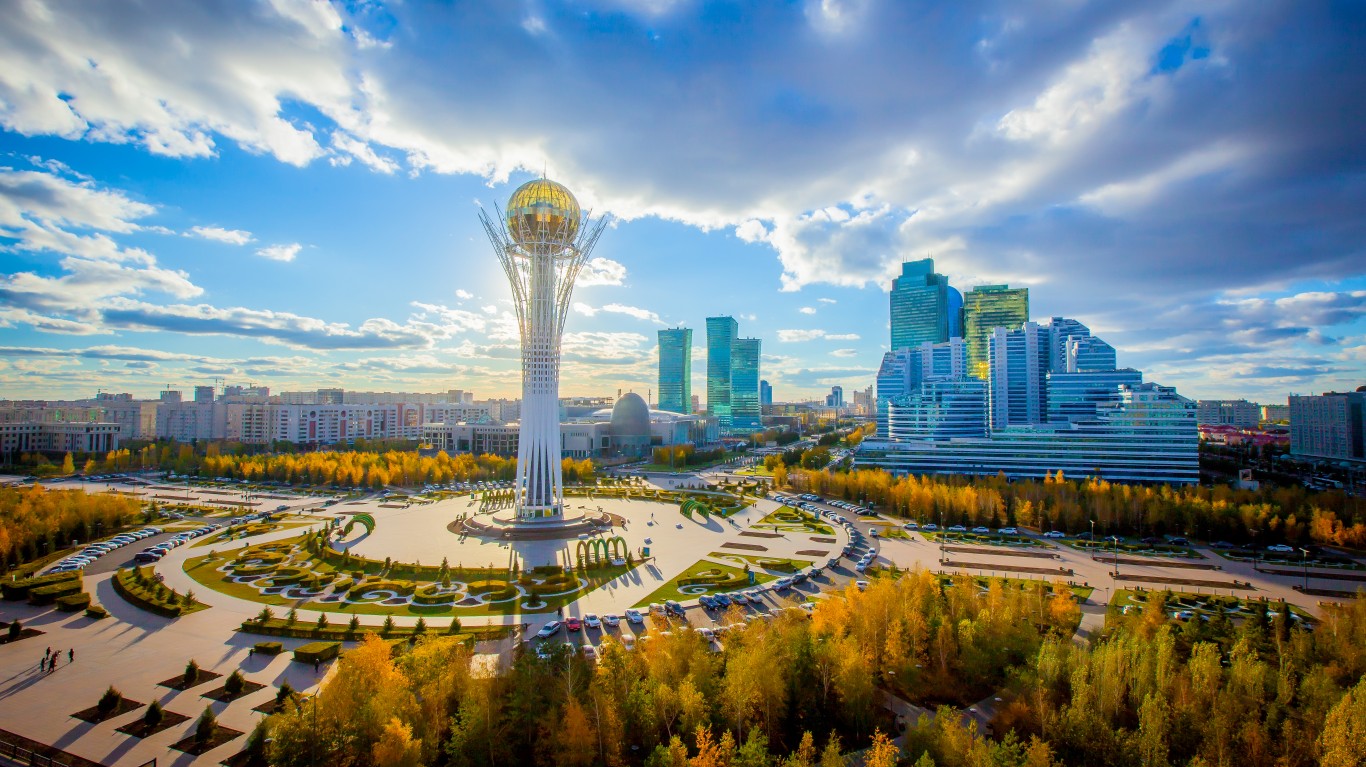
23. Kazakhstan
> PM2.5 concentration: 31.1 μg/m³
> Total population 2020: 18,754,440
Besides motor vehicle exhaust, the biggest contributors to the poor quality of urban air in Kazakhstan are the oil and gas, agricultural, and mining industries. The World Bank estimated in 2013 that air pollution causes 2,300 premature deaths in Kazakhstan and costs the Kazakh economy $1.3 billion annually in increased health care costs.
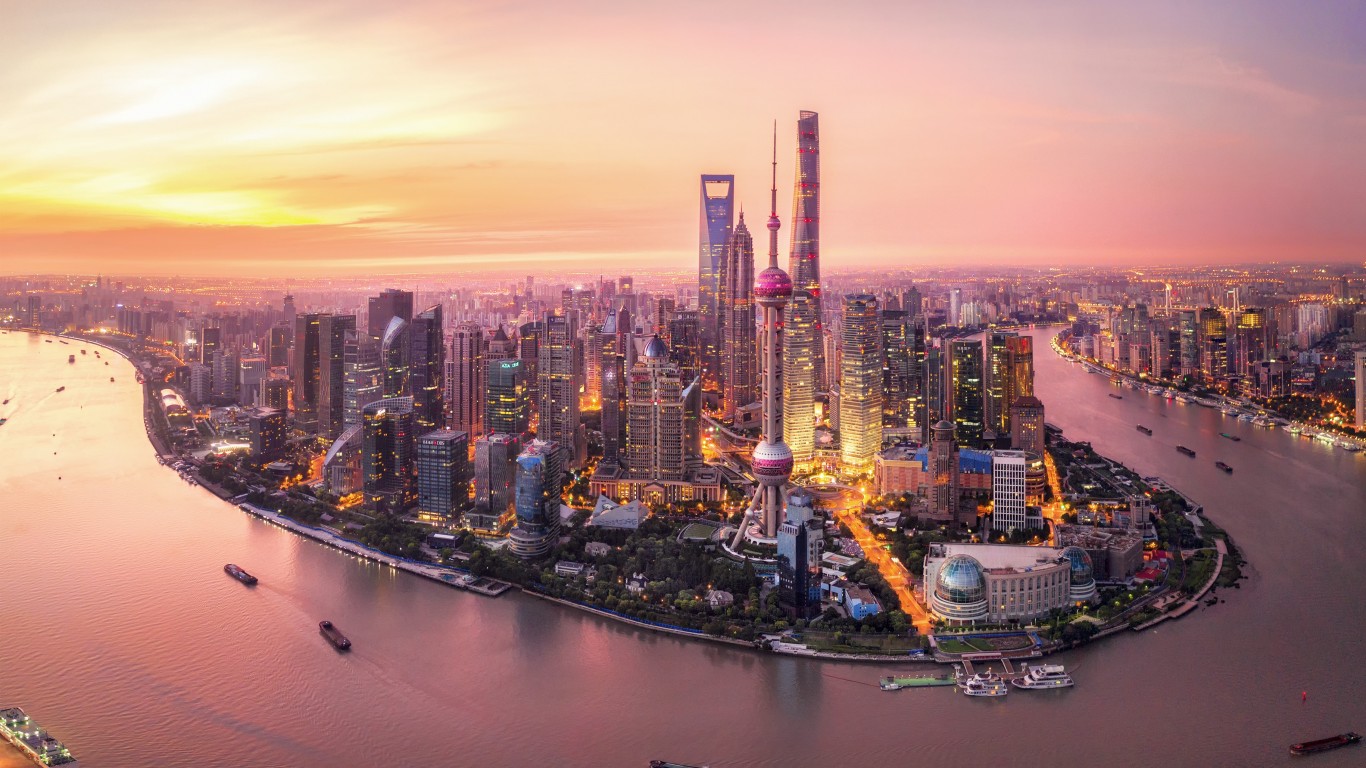
22. China
> PM2.5 concentration: 32.6 μg/m³
> Total population 2020: 1,410,929,362
Emissions controls and a reduction in coal-based power plant activity (including those linked to economic slowdown during the COVID-19 pandemic) helped China curb its urban PM2.5 levels in recent years. But cities in the world’s leading emitter of greenhouse gas still suffer from some of the world’s worst air. A recent study in the medical journal Lancet estimates 1.24 million people died prematurely from exposure to air pollution in China in 2017.
[in-text-ad-2]
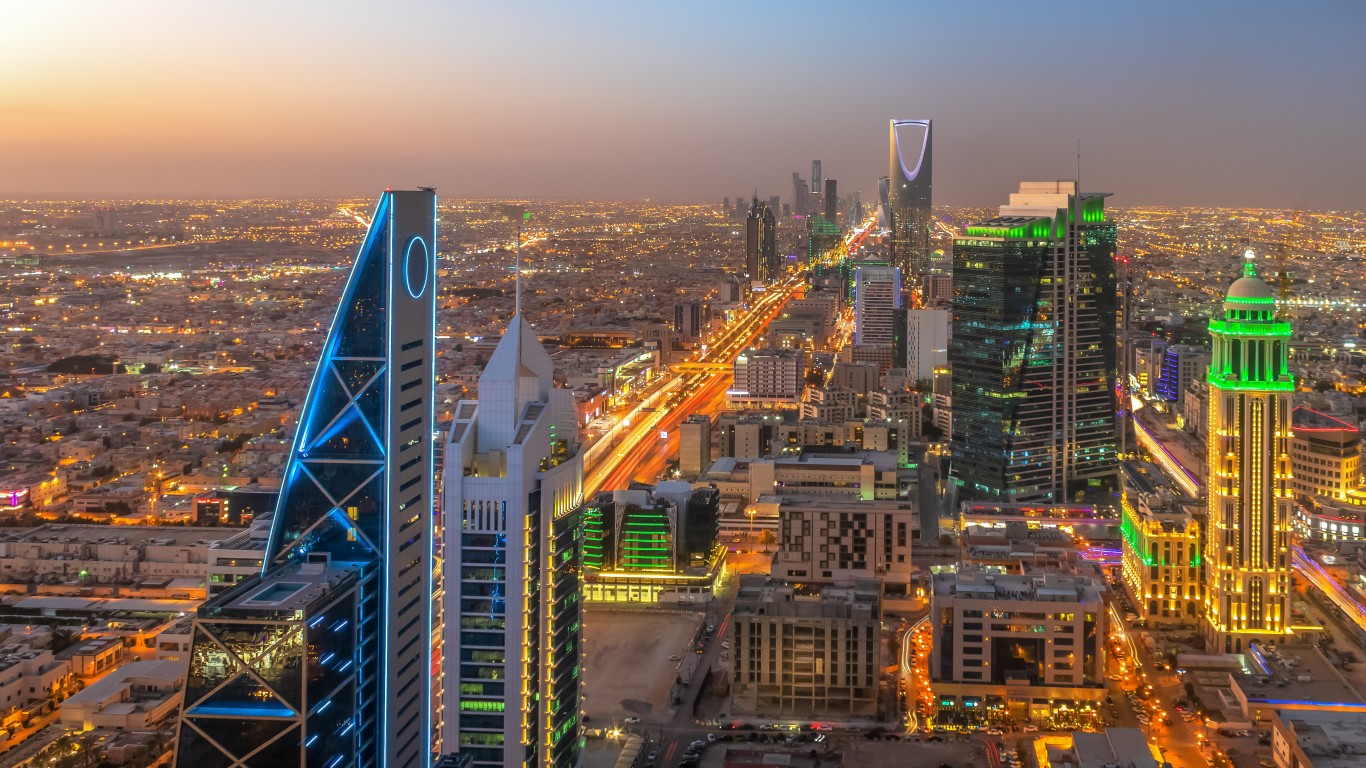
21. Saudi Arabia
> PM2.5 concentration: 32.7 μg/m³
> Total population 2020: 34,813,867
Like its neighbors, Saudi Arabia’s urban air quality is not just profoundly affected by vehicle and industrial emissions but also by seasonal high winds that blow sand and dust into the air. The Saudi cities with the poorest air pollution include the sprawling arid capital city of Riyadh, the buzzing Persian Gulf industrial cities of Jubail and Dammam, and the Red Sea import-focused port city of Jeddah.
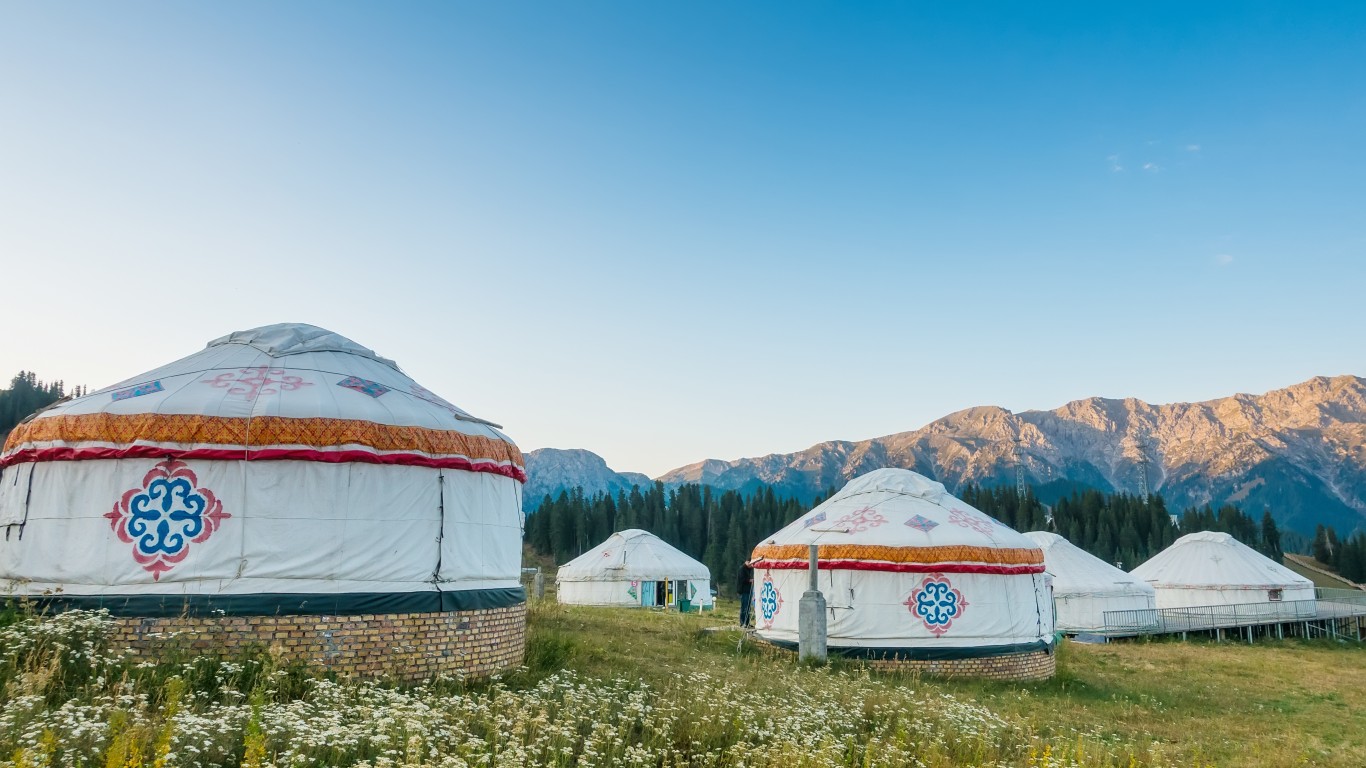
20. Mongolia
> PM2.5 concentration: 33.1 μg/m³
> Total population 2020: 3,278,292
Rapid urbanization of Mongolia’s capital city, where half of the country’s population lives, has created an air-pollution crisis. According to UNICEF, PM2.5 concentrations can average a staggering 687 micrograms per cubic meter of air in the smoggiest parts of Ulaanbaatar on the coldest days of the year. This is thanks to widespread use of coal-burning stoves in the city’s sprawling, impoverished informal settlements.
[in-text-ad]

19. Armenia
> PM2.5 concentration: 33.9 μg/m³
> Total population 2020: 2,963,234
Poor urban air quality in this Eurasian country is caused mainly by motor vehicle emissions and industrial activities, especially from mining and food processing. According to the Business & Human Rights Resource Centre, a U.K.-based global corporate watchdog group, underregulated basalt and clay mines owned by former government officials are a significant contributor to air pollution in the Armenian capital city of Yerevan.
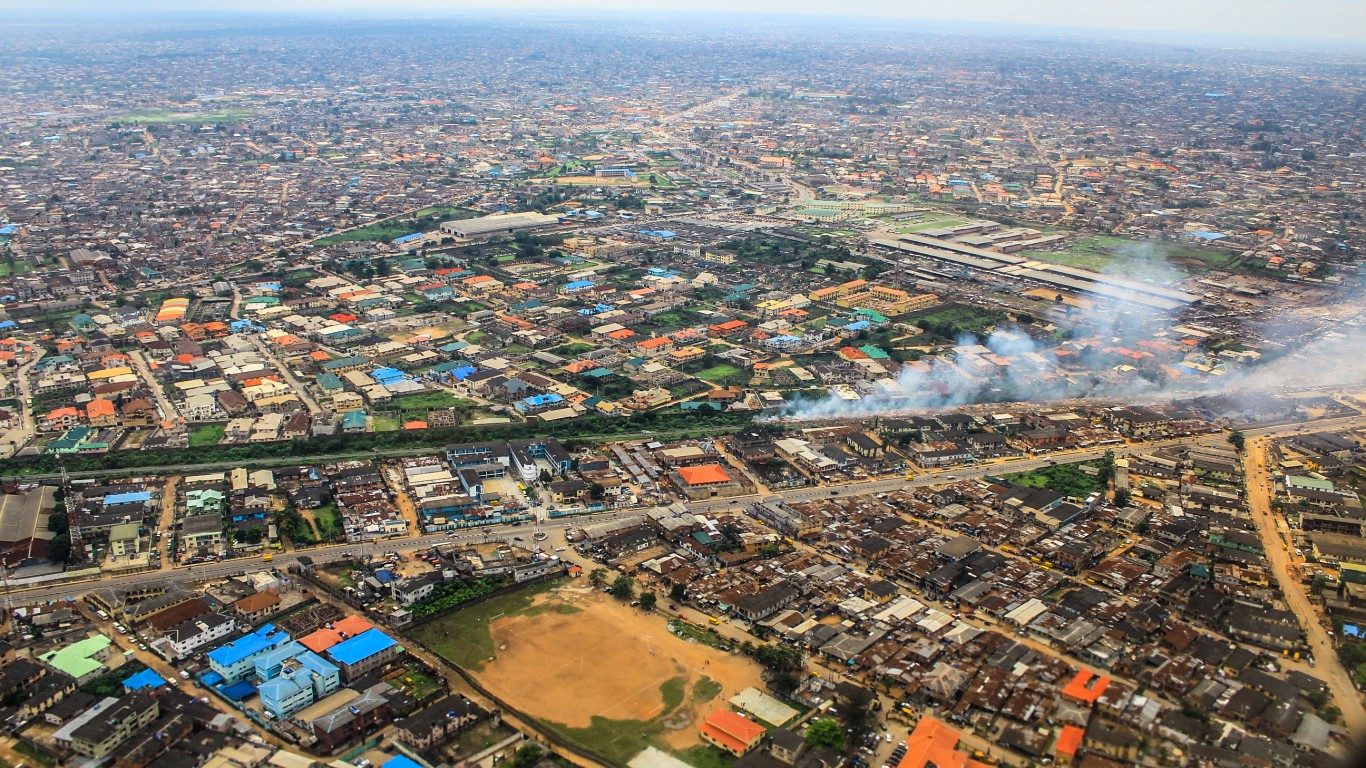
18. Nigeria
> PM2.5 concentration: 34.0 μg/m³
> Total population 2020: 206,139,587
Africa’s largest country by population also tops Africa’s list of countries with the highest number of premature deaths linked to poor urban air quality. In addition to the usual suspects of motor vehicle and industrial emissions, sources of Nigeria’s urban air pollution include the widespread habit of trash-burning due to lack of adequate waste management infrastructure and the broad use of firewood and coal to cook meals.
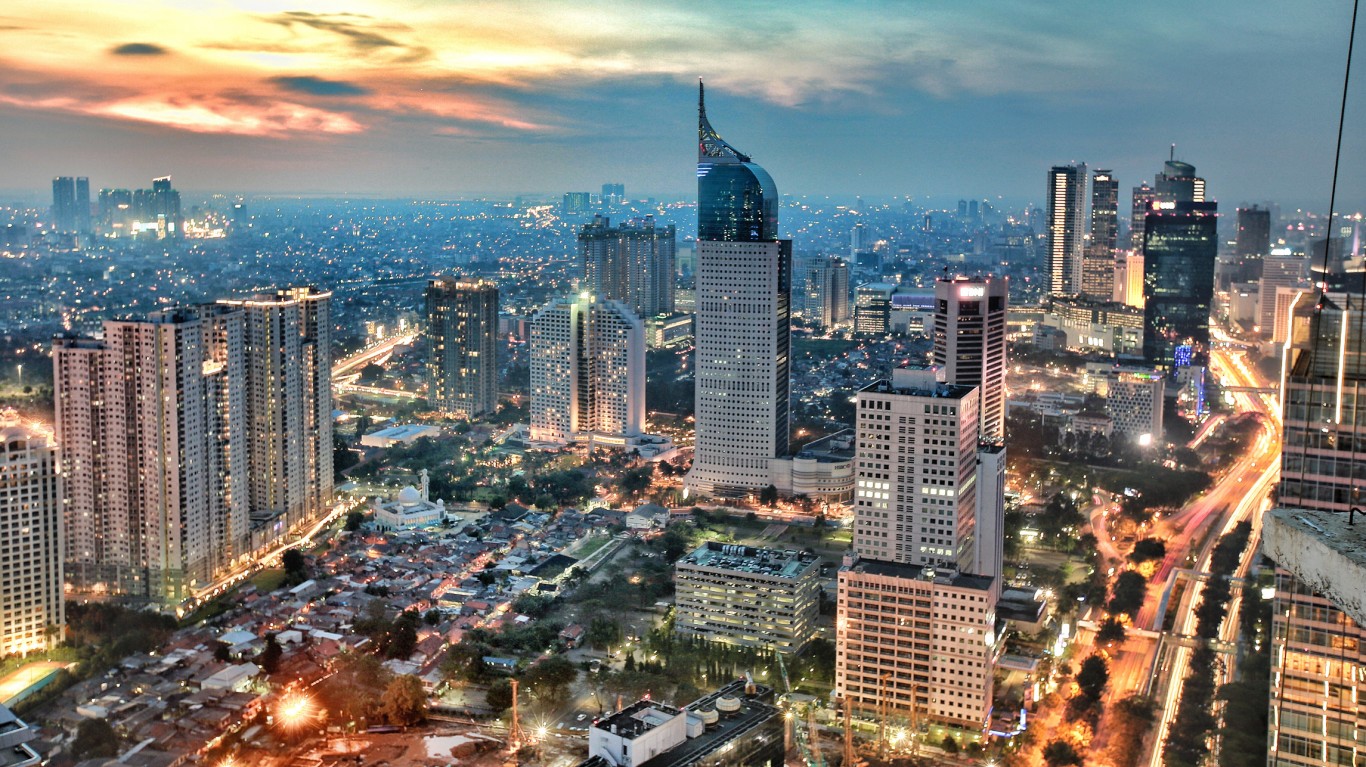
17. Indonesia
> PM2.5 concentration: 34.3 μg/m³
> Total population 2020: 273,523,621
In addition to motor vehicle exhaust, the main contributors to poor urban air quality in the world’s fourth most-populous country are the oil and gas, mining, and automobile industries. Widespread forest fires during the dry season are also a factor. Indonesians lose an average of 1.2 years of life expectancy because of these pollutants, according to the University of Chicago’s Air Quality Life Index.
[in-text-ad-2]

16. Montenegro
> PM2.5 concentration: 35.2 μg/m³
> Total population 2020: 621,306
Montenegro is the only country on this list with a population under 1 million. This small and scenic Balkan country has relatively sizable steelmaking, agricultural processing, and aluminum industries that contribute to high PM2.5 levels.
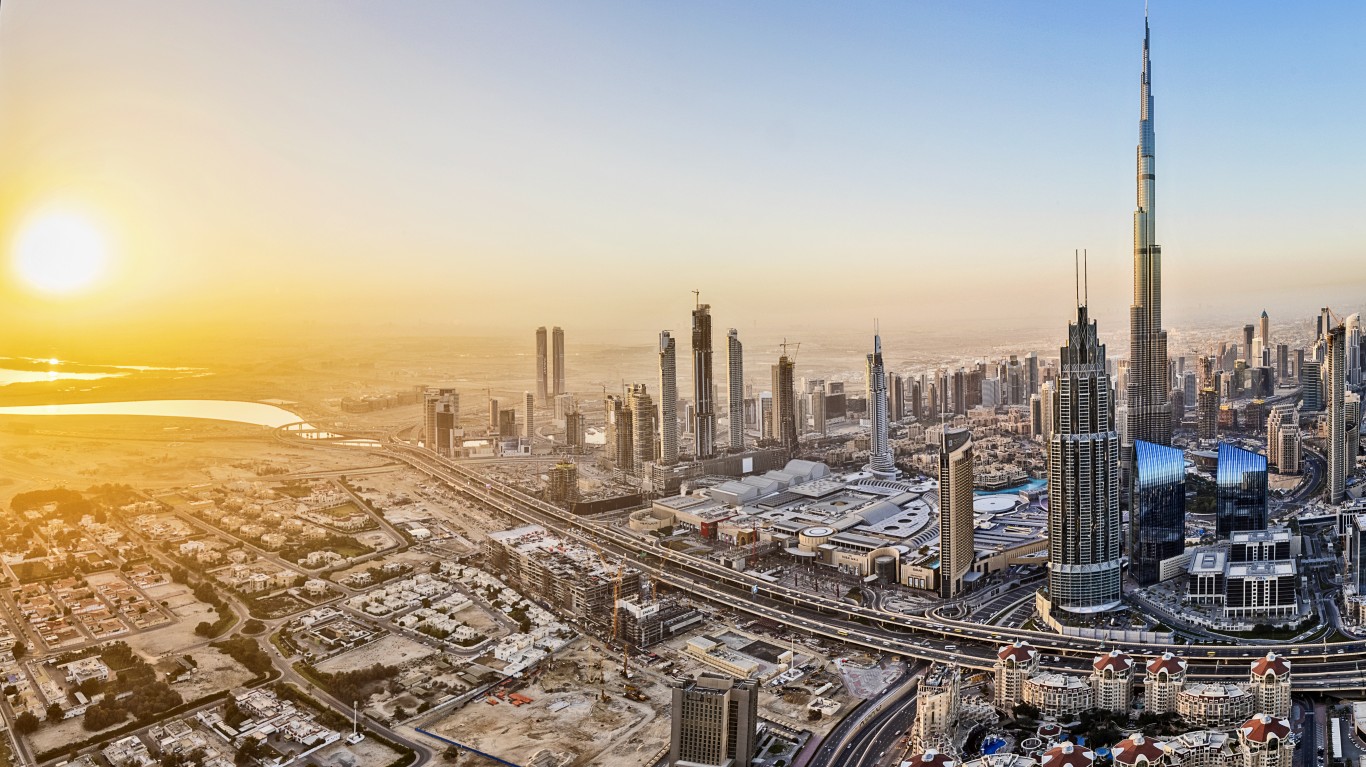
15. United Arab Emirates
> PM2.5 concentration: 36.0 μg/m³
> Total population 2020: 9,890,400
Like its neighbors, air quality in the United Arab Emirates is caused partly by strong seasonal winds that blow across the Arabian Peninsula, causing dust storms in the desert climate. But vehicle and industrial emissions, especially ones linked to oil and gas production and refining, make matters far worse.
[in-text-ad]
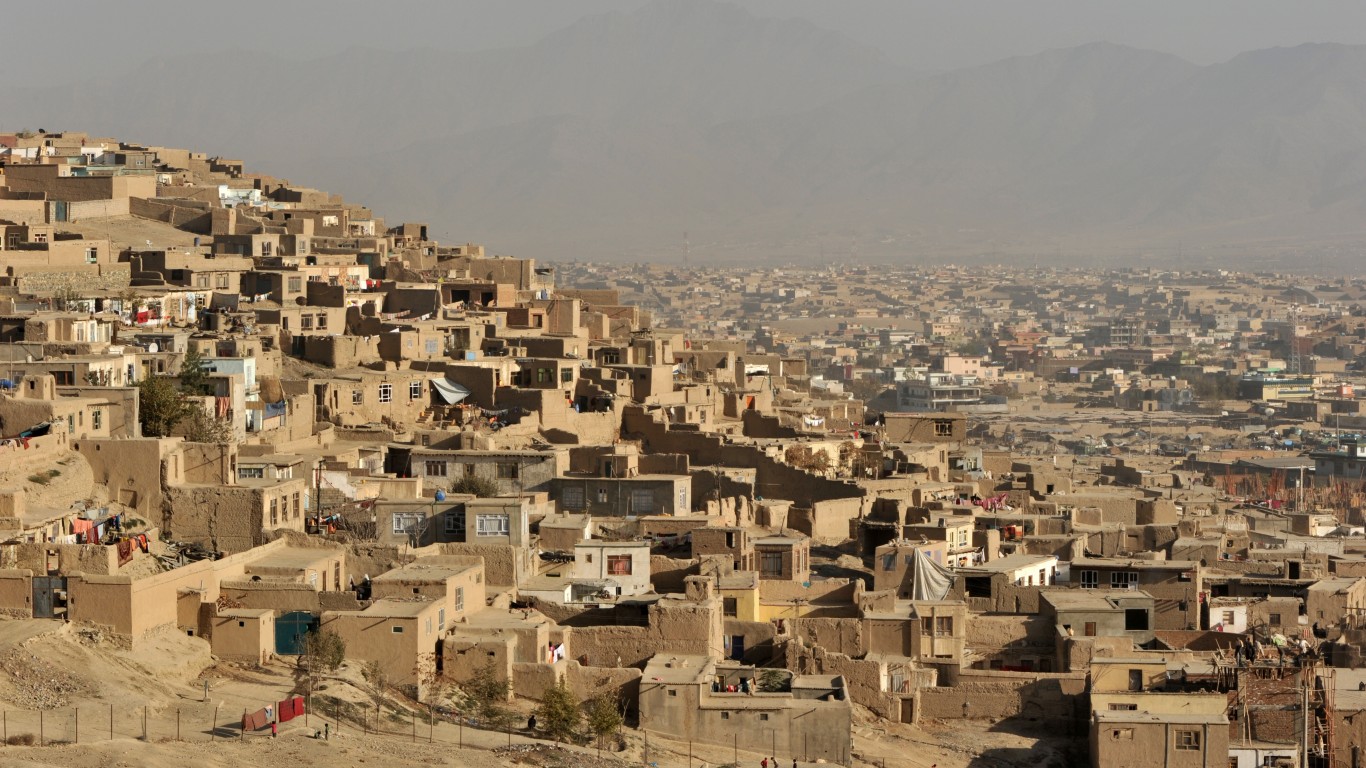
14. Afghanistan
> PM2.5 concentration: 37.5 μg/m³
> Total population 2020: 38,928,341
One of the world’s poorest, least developed, and conflict-ravaged countries is also suffering from a rise in urban air pollution. A primary cause of airborne microparticles is the widespread domestic use of wood and coal for cooking and heat. Dirtier, low-quality fuel upon which Afghans depend exacerbates the air pollution problem.

13. Qatar
> PM2.5 concentration: 38.2 μg/m³
> Total population 2020: 2,881,060
As with other Gulf countries, Qatar’s air quality worsens during periods of seasonal high winds in its arid climate. Further helping push up PM2.5 readings year-round are motor vehicle and industrial emissions. Last year, local officials announced efforts to boost air quality monitoring ahead of the FIFA 2022 World Cup that kicks off in November.

12. Uzbekistan
> PM2.5 concentration: 42.8 μg/m³
> Total population 2020: 34,232,050
Uzbekistan is one of four Central Asian countries on this list. The oil and gas and mining industries contribute to the country’s poor urban air quality, as do widespread burning of residential waste.
[in-text-ad-2]
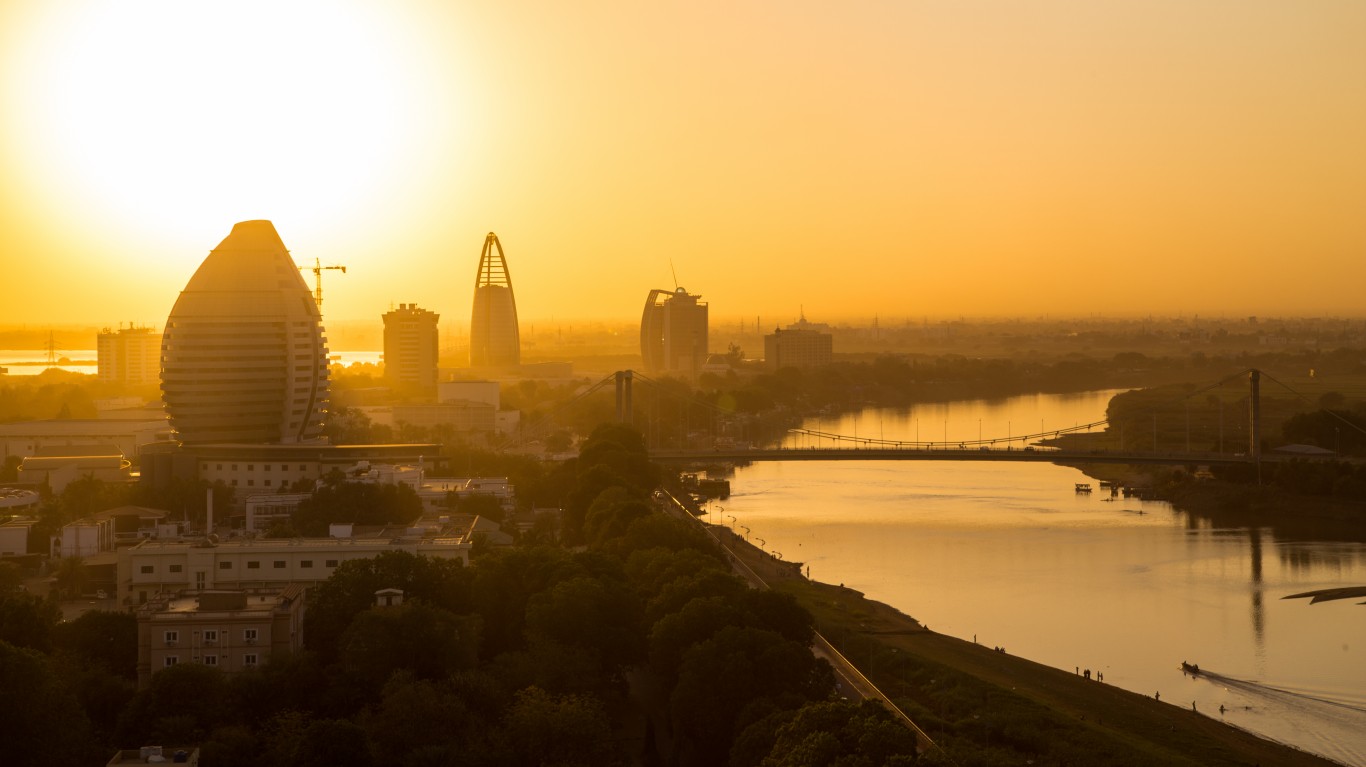
11. Sudan
> PM2.5 concentration: 44.1 μg/m³
> Total population 2020: 43,849,269
The biggest contributors to Sudan’s air pollution problems are the oil and cement industries, motor vehicle emissions, and widespread domestic waste burning due to inadequate waste management infrastructure.

10. Nepal
> PM2.5 concentration: 46.0 μg/m³
> Total population 2020: 29,136,808
Air pollution is the second-highest risk factor (behind malnutrition) of death and disability in Nepal, according to the U.S. Agency for International Development. The capital of Kathmandu is situated on a high plateau ringed by mountains, ideal conditions for thermal inversions, where warmer air higher up acts like a lid that keeps cooler air (and air pollution) closer to ground level inside this topographic bowl.
[in-text-ad]
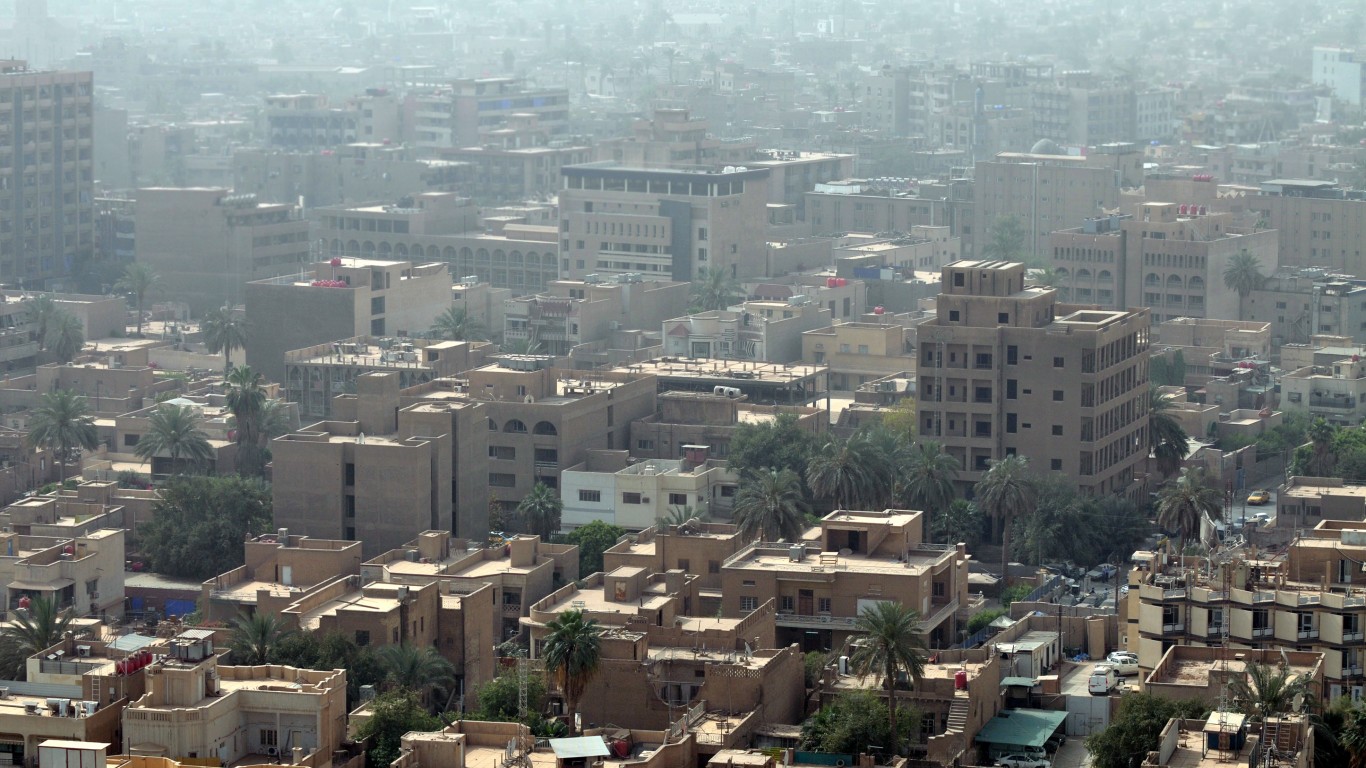
9. Iraq
> PM2.5 concentration: 49.7 μg/m³
> Total population 2020: 40,222,503
Iraq’s poor air quality is caused primarily by vehicle emissions, gas-powered generators due to lack of cleaner electrical infrastructure, and oil and gas industry emissions. Like other desert countries in the region, seasonal winds send massive amounts of sand and dust into the air during parts of the year.
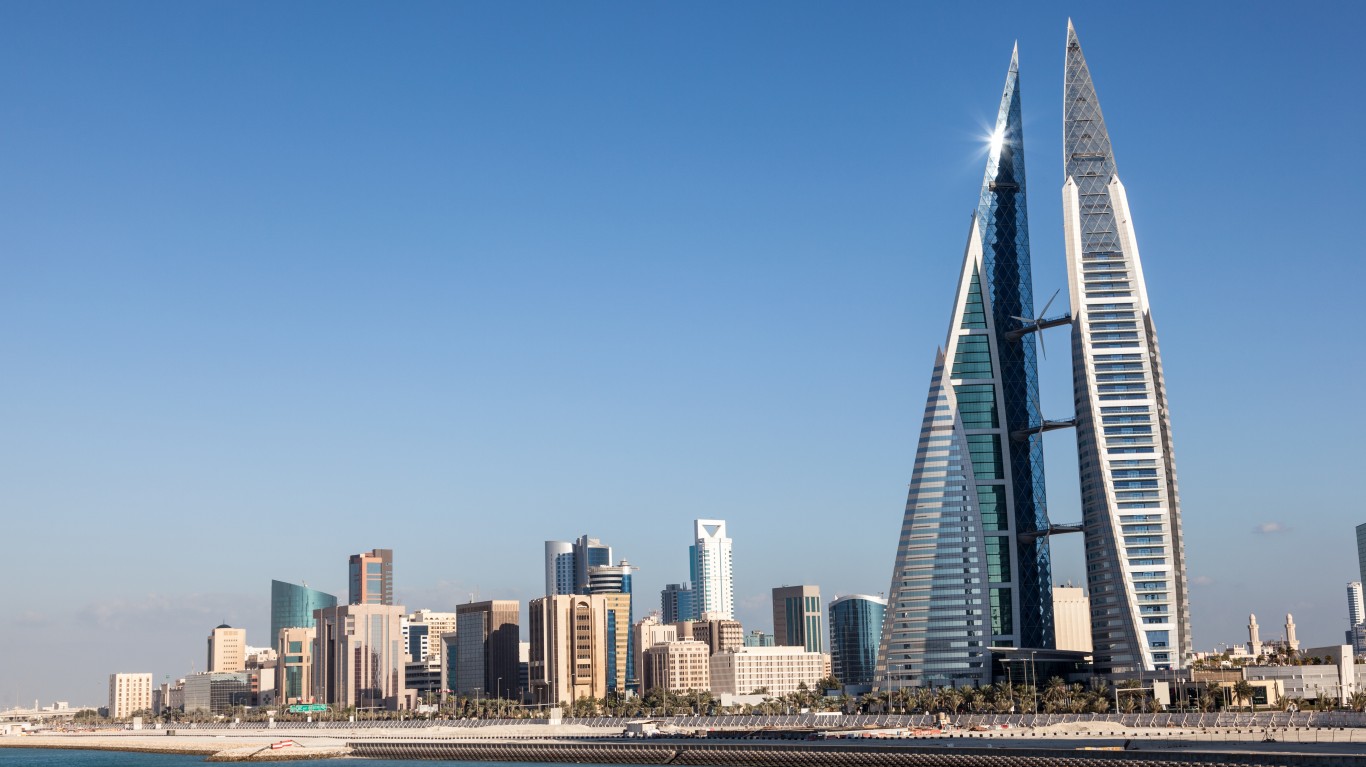
8. Bahrain
> PM2.5 concentration: 49.8 μg/m³
> Total population 2020: 1,701,583
Bahrain has the second-worst air quality of the eight Middle Eastern countries on this list. Oil and natural gas and fertilizer industries contribute to the poor air quality of this island country in the Persian Gulf, as do nearby Saudi Arabian petroleum activities. Seasonal high winds also kick up sand and dust in Bahrain and across the region.
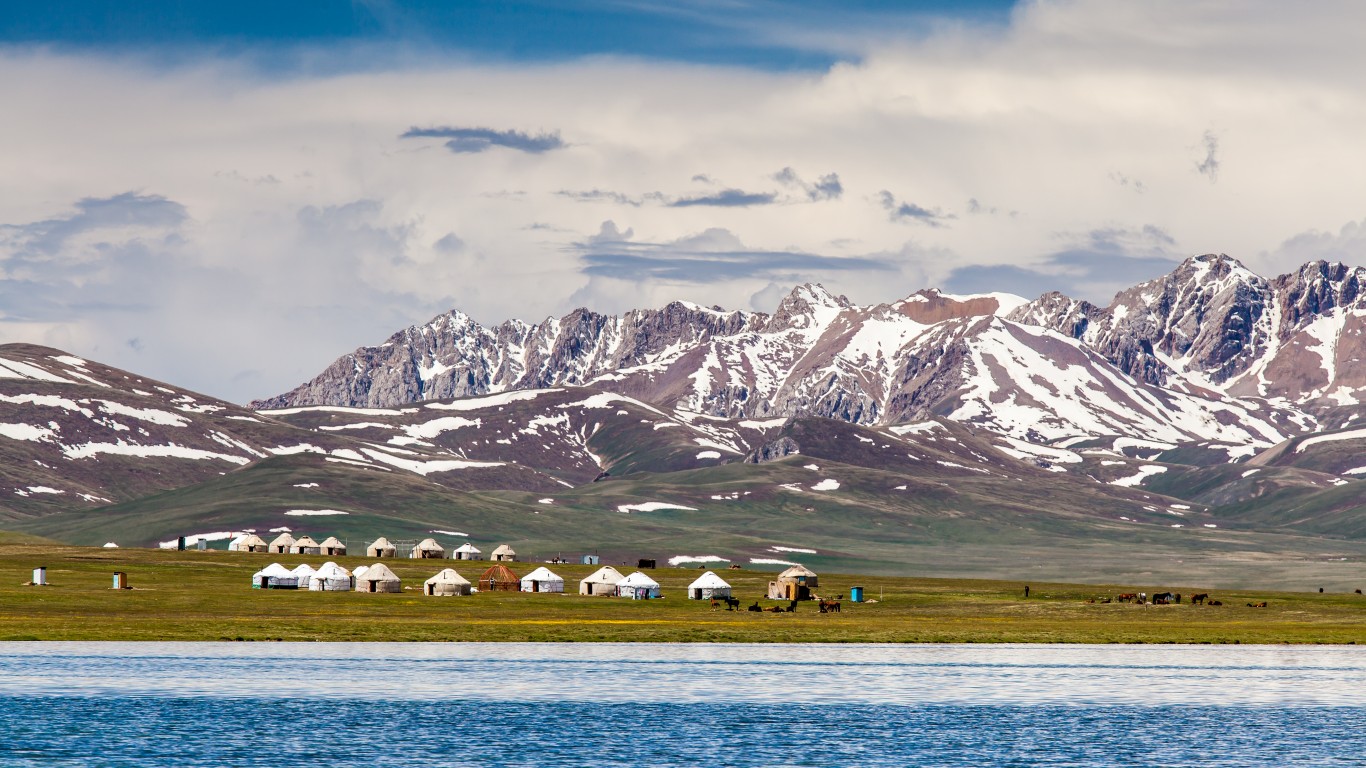
7. Kyrgyz Republic
> PM2.5 concentration: 50.8 μg/m³
> Total population 2020: 6,591,600
Kyrgyzstan is one of four Central Asian countries with the world’s poorest air quality. Thick smog is a common feature in the capital city of Bishkek, which recorded the world’s highest level of air pollution for several days in the winter of 2021 thanks to widespread burning of coal and wood for domestic heating and cooking.
[in-text-ad-2]

6. Oman
> PM2.5 concentration: 53.9 μg/m³
> Total population 2020: 5,106,622
Though Oman’s oil and gas industry is not as large as its Gulf neighbors, there is enough crude production and refining activity to contribute significantly to air pollution in this sultanate situated at the horn of the Arabian Peninsula. Oman registered the worst air quality in the Middle East in 2021, partly due to its proximity to one of the world’s narrowest and busiest shipping channels.
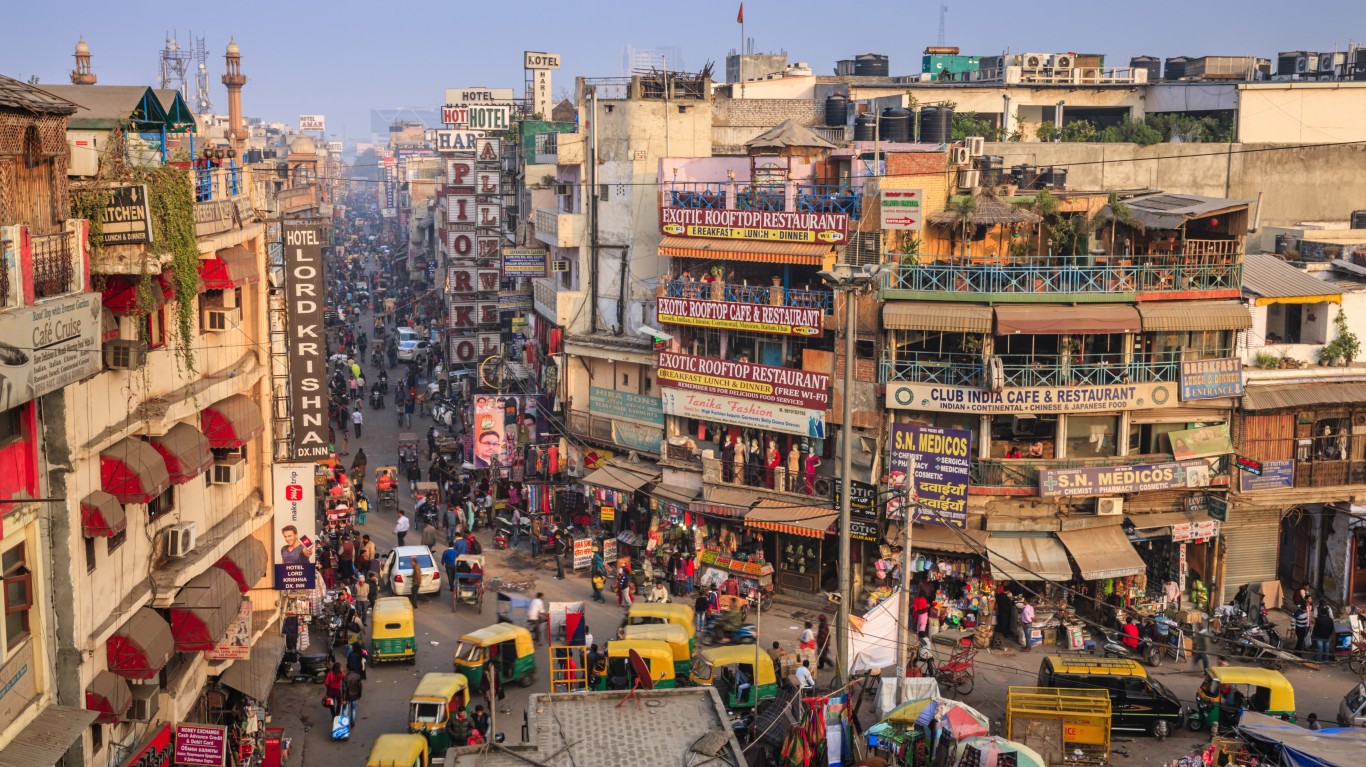
5. India
> PM2.5 concentration: 58.1 μg/m³
> Total population 2020: 1,380,004,385
India might not have the world’s worst air pollution (at least in terms of PM2.5 concentration levels) but its dismal air quality arguably impacts the largest number of people. India’s population is smaller than China’s by 31 million people, but its largest and densest cities experience more days of horrific smog.
In November, most of New Delhi recorded an air quality index reading above 500, and in some locations the reading hit the maximum measurable level of 999, caused by Diwali holiday revelers violating a citywide ban on fireworks. When AQI readings rise above 300, all people are advised to avoid all outdoor physical activity.
[in-text-ad]
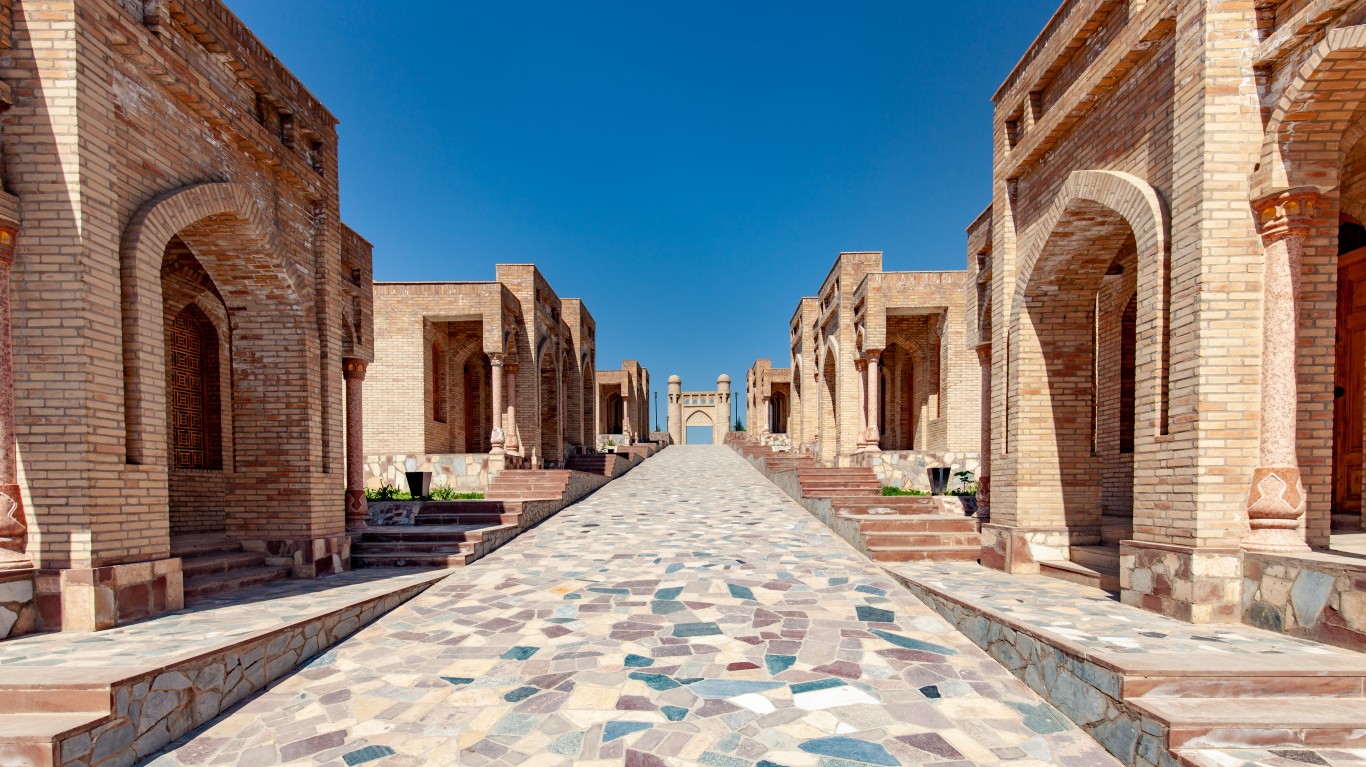
4. Tajikistan
> PM2.5 concentration: 59.4 μg/m³
> Total population 2020: 9,537,642
Tajikistan has the worst air quality of Central Asian countries, by a considerable margin, and its air pollution levels have doubled since 2020. Besides motor vehicle emissions, contributors to this problem include emissions from aluminum processing plants. Air quality in the country’s capital Dushanbe is expected to deteriorate further as the country builds more coal-fired facilities to boost power and industrial production.

3. Pakistan
> PM2.5 concentration: 66.8 μg/m³
> Total population 2020: 220,892,331
Pakistan is the largest of the world’s three countries with the worst air quality. In Lahore and Karachi, air quality index measurements routinely top 300, the threshold at which health officials recommend all people avoid outdoor activity. Trash burning is a major contributor to poor air quality in Pakistan

2. Chad
> PM2.5 concentration: 75.9 μg/m³
> Total population 2020: 16,425,859
Chad has much worse urban air quality than the other two African countries on this list. Contributing to the problem are primarily the oil, textile, and meat-processing industries. Exposure to outdoor particulate matter and household air pollution from the widespread use of wood- or coal-burning stoves was determined to be the third-leading health risk after malnutrition and poor sanitation in 2017, according to the State of Global Affairs website.
[in-text-ad-2]
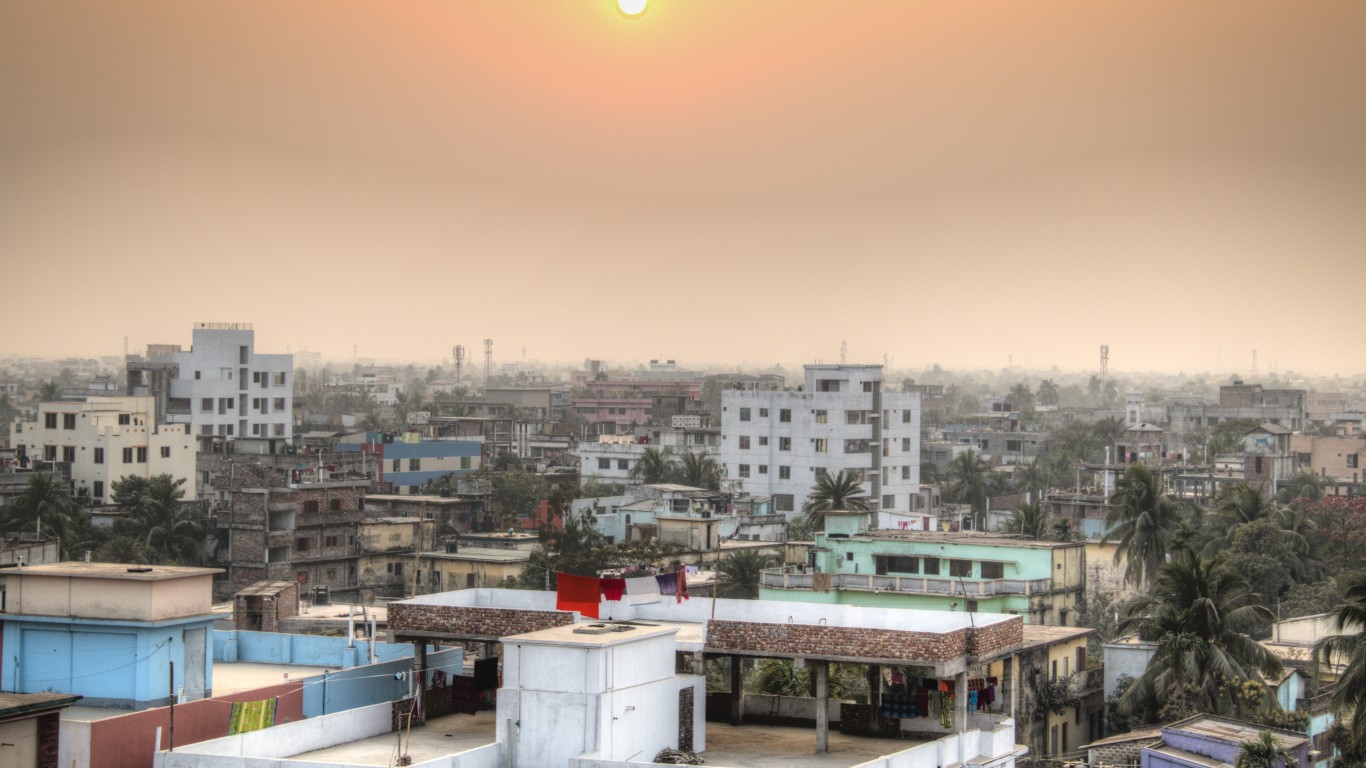
1. Bangladesh
> PM2.5 concentration: 76.9 μg/m³
> Total population 2020: 164,689,383
Urban sprawl, construction, a lack of centralized pollution-mitigation management, lax regulation, and high levels of airborne pollution blowing in from nearby Indian coal mining operations are the largest contributing factors to Bangladesh’s growing air quality crisis. The country’s air pollution is estimated to have jumped by 10% last year compared to the previous year, according to the 2021 World Air Quality Index report.
Get Ready To Retire (Sponsored)
Start by taking a quick retirement quiz from SmartAsset that will match you with up to 3 financial advisors that serve your area and beyond in 5 minutes, or less.
Each advisor has been vetted by SmartAsset and is held to a fiduciary standard to act in your best interests.
Here’s how it works:
1. Answer SmartAsset advisor match quiz
2. Review your pre-screened matches at your leisure. Check out the advisors’ profiles.
3. Speak with advisors at no cost to you. Have an introductory call on the phone or introduction in person and choose whom to work with in the future
Thank you for reading! Have some feedback for us?
Contact the 24/7 Wall St. editorial team.
 24/7 Wall St.
24/7 Wall St. 24/7 Wall St.
24/7 Wall St.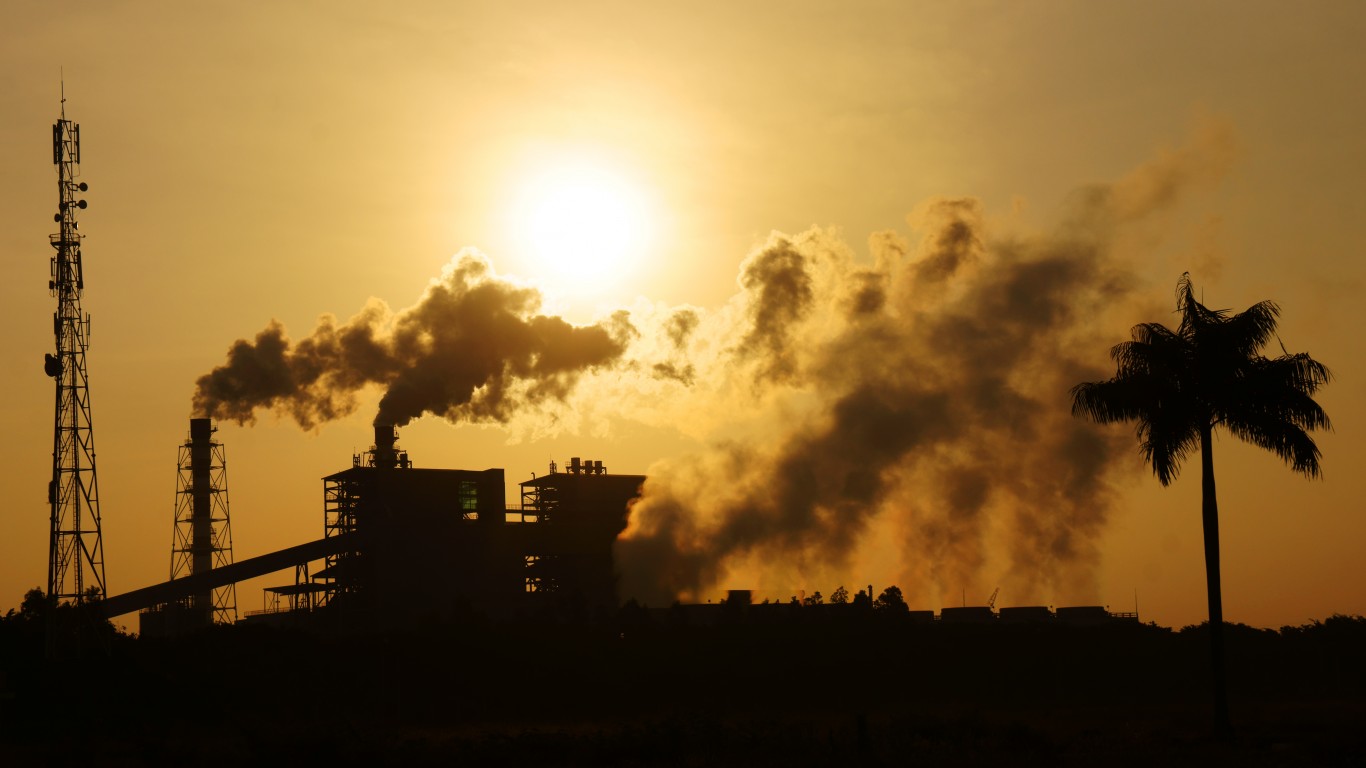 24/7 Wall St.
24/7 Wall St. 24/7 Wall St.
24/7 Wall St.